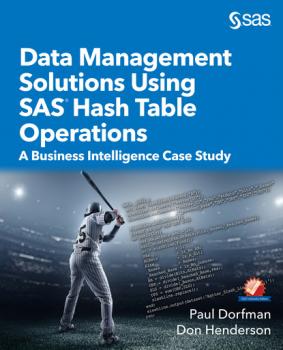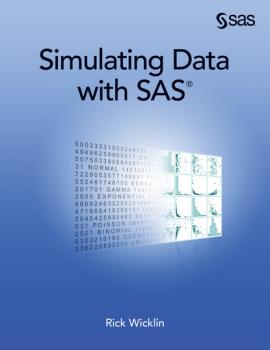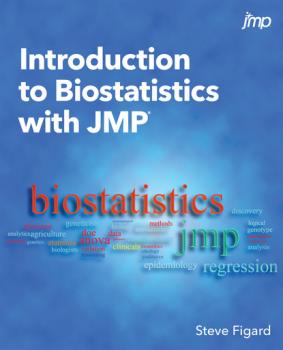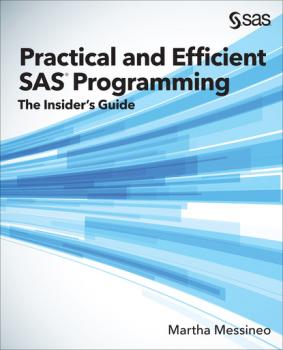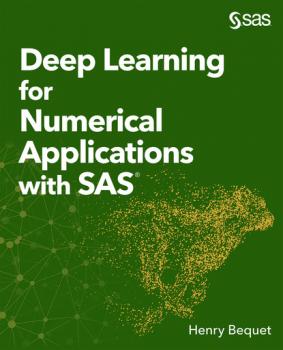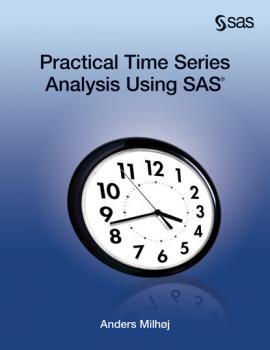ТОП просматриваемых книг сайта:
Скачать книги из серии
Аннотация
Hash tables can do a lot more than you might think! <I>Data Management Solutions Using SAS Hash Table Operations: A Business Intelligence Case Study</I> concentrates on solving your challenging data management and analysis problems via the power of the SAS hash object, whose environment and tools make it possible to create complete dynamic solutions. To this end, this book provides an in-depth overview of the hash table as an in-memory database with the CRUD (Create, Retrieve, Update, Delete) cycle rendered by the hash object tools. By using this concept and focusing on real-world problems exemplified by sports data sets and statistics, this book seeks to help you take advantage of the hash object productively, in particular, but not limited to, the following tasks: <ul> <li> select proper hash tools to perform hash table operations <li> use proper hash table operations to support specific data management tasks <li> use the dynamic, run-time nature of hash object programming <li> understand the algorithmic principles behind hash table data look-up, retrieval, and aggregation <li> learn how to perform data aggregation, for which the hash object is exceptionally well suited <li> manage the hash table memory footprint, especially when processing big data <li> use hash object techniques for other data processing tasks, such as filtering, combining, splitting, sorting, and unduplicating. </ul> Using this book, you will be able to answer your toughest questions quickly and in the most efficient way possible!
Аннотация
Data simulation is a fundamental technique in statistical programming and research. Rick Wicklin's Simulating Data with SAS brings together the most useful algorithms and the best programming techniques for efficient data simulation in an accessible how-to book for practicing statisticians and statistical programmers.
This book discusses in detail how to simulate data from common univariate and multivariate distributions, and how to use simulation to evaluate statistical techniques. It also covers simulating correlated data, data for regression models, spatial data, and data with given moments. It provides tips and techniques for beginning programmers, and offers libraries of functions for advanced practitioners.
As the first book devoted to simulating data across a range of statistical applications, Simulating Data with SAS is an essential tool for programmers, analysts, researchers, and students who use SAS software.
This book is part of the SAS Press program.
This book discusses in detail how to simulate data from common univariate and multivariate distributions, and how to use simulation to evaluate statistical techniques. It also covers simulating correlated data, data for regression models, spatial data, and data with given moments. It provides tips and techniques for beginning programmers, and offers libraries of functions for advanced practitioners.
As the first book devoted to simulating data across a range of statistical applications, Simulating Data with SAS is an essential tool for programmers, analysts, researchers, and students who use SAS software.
This book is part of the SAS Press program.
Аннотация
Confidently navigate your JMP Scripting Language journey with this example-driven guide! With more than 200 example scripts and applications, JSL Companion: Applications of the JMP Scripting Language, Second Edition provides scripters with a resource that takes them beyond the basics of the JMP Scripting Language (JSL) and serves as a companion to writing applications. Avid JSL scripters Theresa L. Utlaut, Georgia Z. Morgan, and Kevin C. Anderson have tapped their expertise to write a task-oriented approach that allows readers to learn scripting by immersion. This edition builds on the earlier edition with substantial new content for scripting enhanced JMP features, such as Graph Builder, new query methods, and enriched display box functionality. A new chapter is dedicated to creating applications with the Add-In Builder and Application Builder. The “Know Your Tools” topic has been expanded, including a section on how to use the JMP Debugger. The book begins with an introduction that is intended for the JSL novice and quickly moves into the building blocks of JSL, which include input and output, working with data tables, script-writing essentials, and JMP data structures. The next chapters provide the foundation for building an application and focus on creating reports, communicating with users, customizing displays, and writing flexible scripts. The final chapters include building and deploying applications and helpful tips on planning scripts, debugging, and improving performance.
Аннотация
Business intelligence (BI) software provides an interface for multiple audiences to dissect, discover, and decide what the data means. These reporting tools make dynamic information available to all users, giving everyone the ability to manipulate results and further understand the business. There is significant power in reducing the data gatekeeper role in your organization so that each person can quickly interact with data and uncover additional value. SAS offers a BI solution that provides mechanisms to reach every level of the organization. Each tool in this solution provides a different amount of complexity and functionality to aid a broad deployment. Building Business Intelligence Using SAS: Content Development Examples, by Tricia Aanderud and Angela Hall, clarifies how you can fully leverage each SAS BI solution component to ensure a successful implementation.
Focusing on the SAS BI Clients, the authors provide a quick-start guide loaded with examples and tips that will help users move quickly from using only one of the SAS BI Clients to using a significant portion of the system. So if you are a SAS BI or SAS Enterprise BI user, but you aren't yet using all the components of the solution, this book is the resource that you need. In addition, the tips and techniques provided in this book will prove invaluable for advanced SAS BI and SAS Enterprise BI users who are studying for SAS Certified BI Content Developer certification.
This book is part of the SAS Press program.
Focusing on the SAS BI Clients, the authors provide a quick-start guide loaded with examples and tips that will help users move quickly from using only one of the SAS BI Clients to using a significant portion of the system. So if you are a SAS BI or SAS Enterprise BI user, but you aren't yet using all the components of the solution, this book is the resource that you need. In addition, the tips and techniques provided in this book will prove invaluable for advanced SAS BI and SAS Enterprise BI users who are studying for SAS Certified BI Content Developer certification.
This book is part of the SAS Press program.
Аннотация
[b]Explore biostatistics using JMP® in this refreshing introduction [/b] Presented in an easy-to-understand way, Introduction to Biostatistics with JMP® introduces undergraduate students in the biological sciences to the most commonly used (and misused) statistical methods that they will need to analyze their experimental data using JMP. It covers many of the basic topics in statistics using biological examples for exercises so that the student biologists can see the relevance to future work in the problems addressed. The book starts by teaching students how to become confident in executing the right analysis by thinking like a statistician then moves into the application of specific tests. Using the powerful capabilities of JMP, the book addresses problems requiring analysis by chi-square tests, t tests, ANOVA analysis, various regression models, DOE, and survival analysis. Topics of particular interest to the biological or health science field include odds ratios, relative risk, and survival analysis. The author uses an engaging, conversational tone to explain concepts and keep readers interested in learning more. The book aims to create bioscientists who can competently incorporate statistics into their investigative toolkits to solve biological research questions as they arise.
Аннотация
Bridging the gap between statistics texts and SAS documentation, <i>Elementary Statistics Using SAS</i> is written for those who want to perform analyses to solve problems. The first section of the book explains the basics of SAS data sets and shows how to use SAS for descriptive statistics and graphs. The second section discusses fundamental statistical concepts, including normality and hypothesis testing. The remaining sections of the book show analyses for comparing two groups, comparing multiple groups, fitting regression equations, and exploring contingency tables. For each analysis, author Sandra Schlotzhauer explains assumptions, statistical approach, and SAS methods and syntax, and makes conclusions from the results. Statistical methods covered include two-sample <i>t</i>-tests, paired-difference <i>t</i>-tests, analysis of variance, multiple comparison techniques, regression, regression diagnostics, and chi-square tests. <i>Elementary Statistics Using SAS</i> is a thoroughly revised and updated edition of Ramon Littell and Sandra Schlotzhauer's <i>SAS System for Elementary Statistical Analysis</i>.
<p>
This book is part of the SAS Press program.
<p>
This book is part of the SAS Press program.
Аннотация
Learn to write SAS programs quickly and efficiently. Programming in SAS is flexible, but it can also be overwhelming. Many novice and experienced programmers learn how to write programs that use the DATA step and macros, but they often don’t realize that a simpler or better way can achieve the same results. In a user-friendly tutorial style, [i]Practical and Efficient SAS Programming: The Insider's Guide provides general SAS programming tips that use the tools available in Base SAS, including the DATA step, the SAS macro facility, and SQL. Drawing from the author’s 30 years of SAS programming experience, this book offers self-contained sections that describe each tip or trick and present numerous examples. It therefore serves as both an easy reference for a specific question, and a useful cover-to-cover read. As a bonus, the utility programs included in the appendixes will help you simplify your programs, as well as help you develop a sleek and efficient coding style. With this book, you will learn how to do the following: use the DATA step, the SAS macro facility, SQL, and other Base SAS tools more efficiently choose the best tool for a task use lookup tables simulate recursion with macros read metadata with the DATA step create your own programming style in order to write programs that are easily maintained Using this book, SAS programmers of all levels will discover new techniques to help them write programs quickly and efficiently.
Аннотация
Solve business problems involving time-to-event and resulting probabilities by following the modeling tutorials in Business Survival Analysis Using SAS®: An Introduction to Lifetime Probabilities, the first book to be published in the field of business survival analysis! Survival analysis is a challenge. Books applying to health sciences exist, but nothing about survival applications for business has been available until now. Written for analysts, forecasters, econometricians, and modelers who work in marketing or credit risk and have little SAS modeling experience, Business Survival Analysis Using SAS® builds on a foundation of SAS code that works in any survival model and features numerous annotated graphs, coefficients, and statistics linked to real business situations and data sets. This guide also helps recent graduates who know the statistics but do not necessarily know how to apply them get up and running in their jobs. By example, it teaches the techniques while avoiding advanced theoretical underpinnings so that busy professionals can rapidly deliver a survival model to meet common business needs.
From first principles, this book teaches survival analysis by highlighting its relevance to business cases. A pragmatic introduction to survival analysis models, it leads you through business examples that contextualize and motivate the statistical methods and SAS coding. Specifically, it illustrates how to build a time-to-next-purchase survival model in SAS® Enterprise Miner, and it relates each step to the underlying statistics and to Base SAS® and SAS/STAT® software. Following the many examples—from data preparation to validation to scoring new customers—you will learn to develop and apply survival analysis techniques to scenarios faced by companies in the financial services, insurance, telecommunication, and marketing industries, including the following scenarios:
Time-to-next-purchase for marketing
Employer turnover for human resources
Small business portfolio macroeconometric stress tests for banks
International Financial Reporting Standard (IFRS 9) lifetime probability of default for banks and building societies
"Churn," or attrition, models for the telecommunications and insurance industries
From first principles, this book teaches survival analysis by highlighting its relevance to business cases. A pragmatic introduction to survival analysis models, it leads you through business examples that contextualize and motivate the statistical methods and SAS coding. Specifically, it illustrates how to build a time-to-next-purchase survival model in SAS® Enterprise Miner, and it relates each step to the underlying statistics and to Base SAS® and SAS/STAT® software. Following the many examples—from data preparation to validation to scoring new customers—you will learn to develop and apply survival analysis techniques to scenarios faced by companies in the financial services, insurance, telecommunication, and marketing industries, including the following scenarios:
Time-to-next-purchase for marketing
Employer turnover for human resources
Small business portfolio macroeconometric stress tests for banks
International Financial Reporting Standard (IFRS 9) lifetime probability of default for banks and building societies
"Churn," or attrition, models for the telecommunications and insurance industries
Аннотация
Foreword by Oliver Schabenberger, PhD Executive Vice President, Chief Operating Officer and Chief Technology Officer SAS Dive into deep learning! Machine learning and deep learning are ubiquitous in our homes and workplaces—from machine translation to image recognition and predictive analytics to autonomous driving. Deep learning holds the promise of improving many everyday tasks in a variety of disciplines. Much deep learning literature explains the mechanics of deep learning with the goal of implementing cognitive applications fueled by Big Data. This book is different. Written by an expert in high-performance analytics, Deep Learning for Numerical Applications with SAS introduces a new field: Deep Learning for Numerical Applications (DL4NA). Contrary to deep learning, the primary goal of DL4NA is not to learn from data but to dramatically improve the performance of numerical applications by training deep neural networks. Deep Learning for Numerical Applications with SAS presents deep learning concepts in SAS along with step-by-step techniques that allow you to easily reproduce the examples on your high-performance analytics systems. It also discusses the latest hardware innovations that can power your SAS programs: from many-core CPUs to GPUs to FPGAs to ASICs. This book assumes the reader has no prior knowledge of high-performance computing, machine learning, or deep learning. It is intended for SAS developers who want to develop and run the fastest analytics. In addition to discovering the latest trends in hybrid architectures with GPUs and FPGAS, readers will learn how to Use deep learning in SAS Speed up their analytics using deep learning Easily write highly parallel programs using the many task computing paradigms This book is part of the SAS Press program.
Аннотация
Anders Milhøj's Practical Time Series Analysis Using SAS explains and demonstrates through examples how you can use SAS for time series analysis. It offers modern procedures for forecasting, seasonal adjustments, and decomposition of time series that can be used without involved statistical reasoning. The book teaches, with numerous examples, how to apply these procedures with very simple coding. In addition, it also gives the statistical background for interested readers. Beginning with an introductory chapter that covers the practical handling of time series data in SAS using the TIMESERIES and EXPAND procedures, it goes on to explain forecasting, which is found in the ESM procedure; seasonal adjustment, including trading-day correction using PROC X12; and unobserved component models using the UCM procedure.
This book is part of the SAS Press program.
This book is part of the SAS Press program.

